Tec 5 Robert 'Bob' Carleton
502nd Parachute Infantry Regiment
E - Company
101st Airborne Division
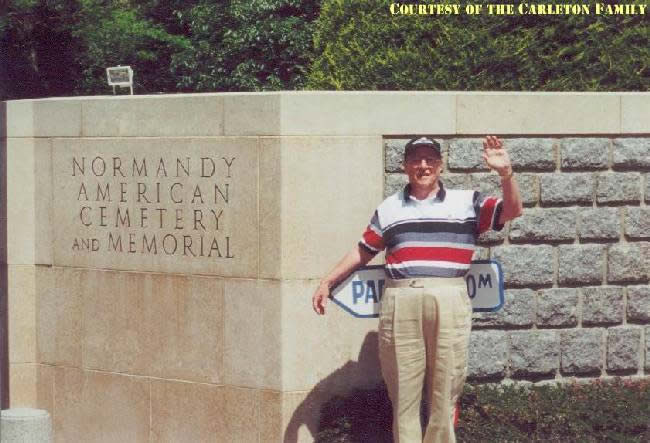
Carleton visited the Colleville US Cemetery in 2001
Volunteering for duty
Robert Carleton was born in 1923. He lived in New
Haven, Connecticut.
In 1940 he graduated from the East Haven High School and started working for
a local florist, making floral arrangements and even delivering flowers.
As did many American men, he volunteered for duty. 'It
was the thing to do at that age...' , he stated in a interview in 2001.
He actually enlisted four days after Independence Day, 1942.
He and a friend went up to the recruiting office together. His friend was turned
down but Carleton joined the Paratroopers and was sent to Camp Croft for basic
training.
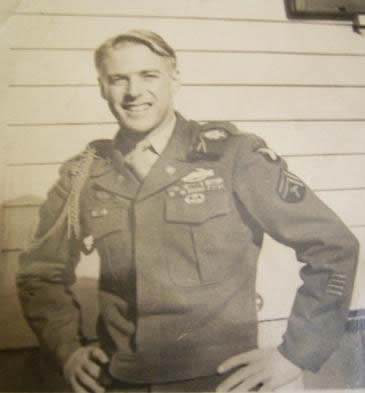
Carleton in Dress Uniform
Training
'The first, and oddly the worst,
part of Airborne training was entirely on the ground. Lungs ached and legs
buckled from long runs, sometimes with full equipment. Crack physical instructors
put the troops through grueling and endless exercises, and judo experts
taught the men the rough and tumble tactics of hand-to-hand combat.'
(The Epic of the 101st Airborne Division.)
Carleton said he joined the paratroopers because
of the 50$ extra pay for hazardous duty. At that time parachuting was considered
extra 'hazardous'. The extra pay was envied by the glidermen who did not
receive such a bonus. 'In those days, 50 bucks was a
lot of money.'
After 13 weeks in basic training he went to Fort Benning, Georgia, for Jump
School training. 'You made five jumps before you earned
your wings, then you were qualified.'
He was assigned to E-Company of the new 502nd Parachute Infantry Regiment,
attached to the 101st Airborne Division. The 101st division was deactivated
after World War I, but reactivated as one of the two unique Airborne Divisions
of the United States on August 16th 1942.
England
After a year of rigorous training the 502nd shipped out for Europe aboard a British ship. Carleton remembered it all very clear. The SS Strathnaver sailed for 6 days before it had to make port on September 11th 1943 in St Johns, Newfoundland for repairs. The ships fresh water tanks were discovered to have salt water in themů It took weeks to repair the ship, and by the time the ship headed back out to sea it hit some rocks in the harbor. A day later and an extra 28 inches of water aboard the men had to wait again. Wait? No way. Road marches, barracks inspection drills and PT (Physical Training) exercises. On October 4th the SS John Ericson docked at Newfoundland and took the men the England, arriving on October 18th. The journey from the US to Engeland took a total of 44 days. 'Everybody aboard received the American Defense Ribbon because it was such a long time at sea', Carleton said.
The troops boarded trains and trucks and traveled
to quarters in Chilton Foliat and Denford near Hungerford (Berkshire). Carleton
went to Hungerford, having to adjust to the rural English countryside. They
continued training; physical tests, full gear marches, first aid training,
map reading, chemical warfare instructions, field problems and training jumps
from 1.500 feet (carrying only a small backpack and a helmet). They also
got acquainted to the weapons and uniforms of the enemy.
The 502nd, or the 'Deuce' as they are also known, participated in some massive
exercises. In March, April and May they joined in Exercise Beaver, Exercise
Tiger and Exercise Eagle. And although the objectives of the Exercises were
dealt with, the latter exercise showed were the paratroopers were the most
venerable; during Exercise Eagle some of the troops were dropped almost 10
miles outside their intended dropzones.
The night before the D-Day invasion Bob Carleton
and his buddy's huddled with General Dwight D. Eisenhower. The supreme allied
commander asked Bob Carleton and the others what they did (before the war).
'... I told him I was a florist', Carleton answered.
'He said: What the hell are you doing in the paratroopers?
I don't know why he thought a guy in the floral business shouldn't be in
the paratroopers!'
Some very famous pictures were taken during the Eisenhower visit to the paratroopers.
One of them shows 'Ike' talking to Lt. Wallace Strobel of E-Company 502nd PIR.
Baptism of Fire
Bob estimated that he carried 150 pounds of gear
for his first combat jump. Amongst other equipment and gear, he jumped into
Normandy with his M-1 rifle and extra supplies of food. Some guys in his
company were packing the so called 'thermite' grenades, supposed to wreck
the inside of the German artillery pieces they were slipped into. At this
time 1st Lt Fred O. Drennan was the commander of Easy Company, 502nd PIR.
Carleton recalled that they got little, if any, sleep after meeting with General
Eisenhower on the night of June 5th. They waited in their marshalling area
for the C-47's to take off at about 11 p.m. Soon after midnight the men of
Bob's stick jumped into occupied France, joining thousandths of American and
British paratroopers and glidermen.
'I think I landed at 12.45 a.m. - I will never forget
that -', Bob stated. 'I landed in the dark in the
courtyard of a chateau and was immediately surrounded by cows. I think they
really protected me while I disengaged my parachute and assembled my weapon.'
Carleton touched down at Ste. Mere Eglise. The paratroopers were scattered
all over the Cherbourg Peninsula and proceeded to try to find each other in
the dark.
'All of us carried a little clicker we were supposed to
use to identify ourselves to other friendly troops.'
'I started clicking, and eventually someone clicked back.
We were not supposed to fire our weapon (at night) because of the possibility
we would kill each other.'
The main objective of Bob's company, an artillery site, turned out to be blown
to smithereens by the Airforce, so the men (about half a dozen at that time)
proceeded to engage the enemy.
The next day 2nd Battalion (including Bob Carleton's Easy Company) was put
in reserve in the vicinity of Hiesville as Division reserve. At that time the
regimental strength had grown from 322 men (in the early evening of D-Day)
to 1.200 officers and men.
The 502nd spend the next 32 days in fire fights, meeting up with other troops
on the way. Carleton recalled several friends were killed in the process of
'eliminating the enemy'. Moving toward Carentan he was wounded in action himself
on the infamous 'Purple Heart Lane'. Before the Carentan battle the 502nd PIR
strength consisted out of 119 Officers and 1342 enlisted men. After the Carentan
battle it was down to 90 officers and 935 enlisted men. Getting wounded in
this fight Bob Carleton received the Purple Heart, but he never spoke about
the details of the carnage, like many of the WW2 soldiers.
After more then a month of fighting the men of the 502nd were moved back to
Utah Beach, loaded on LST boats and shipped back top England. They entered
the Port of Southampton at 08.00 on the 11th of June 1944. They arrived at
Chilton Foliat and Denford in the late afternoon, the next day. Time for R&R,
rest and recuperate.
Battle for Best
September 17th 1944 operation Market Garden started.
The American paratroopers were to keep the 'Highway' open for the British tanks
so they could cross through Belgium and Holland into Germany. Not all of
the operations goals were achieved.
'They claimed the road was not protected so they could
proceed, but it was all the way.' Bob adds. 'It
was a daytime jump and we all landed in the designated drop area - it was certainly
different', Bob said. 2nd Battalion of 502nd PIR landed on the dropzone
at 13.30 and within 1 hour and 10 minutes was 97 percent complete. In Normandy
it took half a night to assemble 6 men...
Carleton and Easy Company were involved in the attack on Best, by the complete
2nd battalion of the 502nd Parachute Infantry Regiment, 101st Airborne Division.
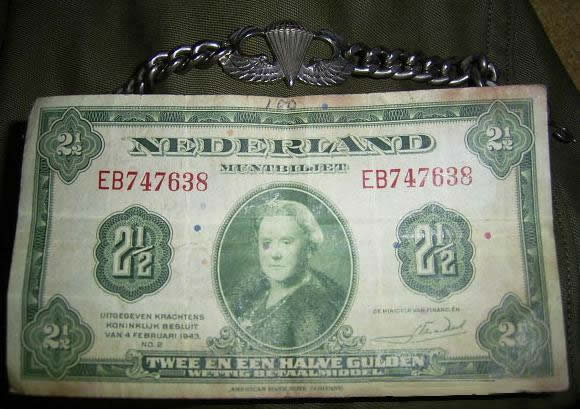
Dutch Currency & Jumpwing Bracelet
The mission to Best was considered of such routine
nature (upon basis of G2 reports) that at first only a platoon had been assigned
to seize the town and the bridge. The force was increased to a company at
the request of the Battalion Commander. So company H moved from dropzone
'B' to the east towards the bridges at Best to clear this routine mission.
But it turned out a complete different story. H-Company had focussed of the
church steeple of Best, figuring that keeping on that line they would hit
the canal halfway between the railroad and highway bridges. Moving through
the woods they had lost sight of the steeple and came out near the highway
about 600 yards north of their calculated point, encountering increasing
enemy fire.
1st Battalion of 502nd had moved into the woods and dug in for the night with
their Main Line of Resistance (MLR) near the edge of the woods, facing towards
Best.
At September 18th the 2nd Battalion of 502nd PIR (Dog, Easy and Fox Company)
was moving towards Best from the north. They had moved in column of companies
to a position at Fraterhoef and set up a perimeter defense the day before.
At 04.00 in the morning Colonel J.H. Michaelis, commander of the 502nd PIR
alerted 2nd battalion to move towards Best. The mission became to drive in
to Best and then swing south to the bridges. Around Molenkampen they encountered
heavy fire but they kept going in the direction of the highway.
The Dutch had been haying and the fields were covered by small piles of uncollected
hay. It turned out to be the only cover for Bob Carleton and his company. On
a wide front the 'line' rippled forward in perfect order, with perfect discipline,
each group of 2 or 3 men dashing to the next hay pile. But the German machineguns
fired into the hay, setting it afire, wounding or killing the behind them.
In the official report it reads; 'I heard someone yell: 'Sergeant Brodie, you're
next'. Another man behind the hay pile yelled: 'Brodie is dead, but I'm coming
on', and he jumped up and ran ahead'.
The strength of the enemy in and around Best had been estimated at one 1/3rd
of what it turned out to be, until the 2nd battalion of the 502nd met it head-on.
Mopping up the area around Best the 502nd made over 1100 prisoners. Supporting
tanks from the 7th British Armored took up positions in the field north of
the Canal. 2nd battalion organized a defensive position on the west of the
road from the Canal. Within this zone they destroyed six 88mm guns.
Eventually Dog, Easy and Fox company left the positions to pull back to St
Oedenrode.
One month later, Best was still in enemy hands, and so was much of the ground
over which the 502nd PIR had fought in the first days, trying for the town
and the bridge.
Bob puts in all in perspective: 'The British paratroopers
where wiped out.' Amongst other reasons because the British tanks didn't
make it all the way along 'Hells Highway'.
As the campaign wore on, the
Dutch countryside became a muddy, wreckage strewn plain. Transports braved
the Flak again and brought supplies for the Eaglemen who were fighting
up and down the flanks of the highway, turning back frequent enemy attempts
to cut the supply route.
(The Epic of the 101st Airborne Division.)
It must have been strange for the men of American Parachute Regiments, to have an English commander like Montgomery, who kept them on the line, functioning as 'normal' front soldiers.
Champagne
After spending more then two months in the damp and
cold clay of Holland the men of the 502nd PIR returned to France, to a staging
area near Reims, the champagne capital of the world.
'I know one thing', Bob said about that period,
'we never drank any water. We drank champagne the whole
time we were there.'
But it wasn't to last...
The Eaglemen had just settled
in France when the frantic alert for Bastogne was issued. The 73-day campaign
in Holland left the sky soldiers sparsely equipped, and it was a miscellany
of uniforms that boarded trucks a few hours after the alert order and headed
for the Belgian Ardennes.
The vast majority were without ammunition until it was doled out to them when
they left the trucks and were marching to the front.
(The Epic of the 101st Airborne Division.)
The Alamo of Europe
At the end of 1944 the German Army started an offensive
that would be known as the 'Battle of the Bulge'. The 101st Airborne Division
was send into the Ardennes to face the German attack. The paratroopers dug
in around Bastogne and faced the enemy and the elements. Snow, fog, ice,
lack of material, equipment, clothing and constant barrages from the enemy.
'When the weather broke, the Airforce was able to send
up P-47s fighter-bombers which strafed the German troops and the tanks that
were firing on us.'
Bob continued; 'I won't say that General Patton rescued
us, but he broke through our area and we were evacuated. But we saved the town
and the big intersection of a major highway that was so important to the German
advance. If they could have made it to Bastogne, they could have advanced in
several directions on several major highways. It was a rough time.'
For 6 days the 101st was completely
cut off by savagely attacking elements of 8th German Divisions. Enemy armor
stabbed in vain at the stubbornly held line, while artillery of all calibers
pounded the frozen little town. This situation was dubbed as 'The Alamo
of Europe', but the troops of the besieged garrison gave themselves the
less glamorous tittle of the 'battered bastards of the Bastogne bastion'.
(The Epic of the 101st Airborne Division.)
Back Home
Bob Carleton separated from the service at Tec5 rank on November 16th 1945, after spending time on furlough in England, Scotland and Wales. He was even stationed in Munich before he returned to the United States.
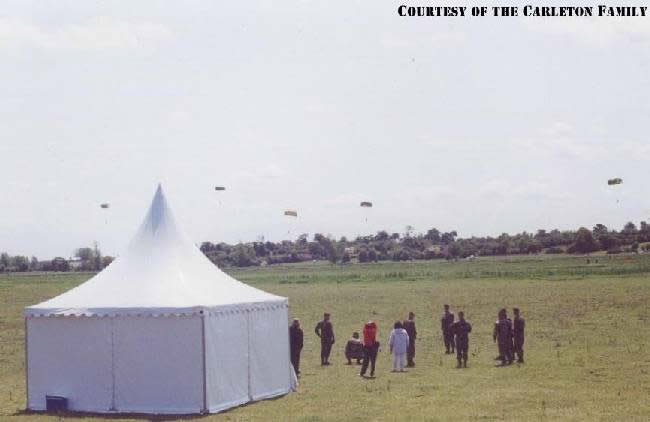
Normandy 2001, Angels from the Sky
The 101st Airborne, holder of
two Presidential Citations, veteran of the Normandy, Holland, Bastogne,
Rhineland and Central Europe campaigns was finished with action, and her
soldiers looked forward to the fulfillment of a long cherished dream, the
sight of the Statue of Liberty from the rail of a homeward bound troopship.
(The Epic of the 101st Airborne Division.)
After writing with his girlfriends mother, Bob Carleton
flew up to Greenville, South Carolina where he got engaged with his Betty
in December.
Bob and Betty married on June 9th 1947, 3 years and 3 days after the D-Day
jump.
Carleton tried to study journalism at the Wagner College in Staten Island,
New York, but he didn't graduate. 'He was much older than
the kids in college', Betty said. 'They were just
children to him after going through all that (his war experiences)'.
So they decided it would be better if Bob went to work.
He worked for years in sales for various companies. They moved to Ashville
where they lived from 1951 to 1976. They raised two daughters and now have
several grand and great-grandchildren. They lived in Hilton-Head, South Carolina,
for seven years, where Bob worked as a real estate broker. Then they moved
back to Ashville in 1983. Hendersonville became their hometown in 1991.
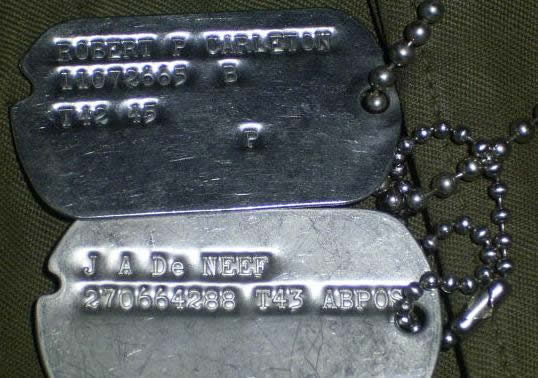
Dogtags of both Robert and John
2001, Back to Normandy
In June 2001 a stick of Living History Paratroopers
jumped above La Fiere, just behind Ste Mere Eglise. Bob Carleton was there,
watching the men float down in their historical uniforms. How come?
It all started with a small advert on the Internet. 'Is anybody Alive from
Easy Company 502nd, WW2?'.
That is when John de Neef, a Dutch Living History enthusiast and actual parachutist,
got into contact with Bob Carleton. John was planning on doing the ultimate
thing in his pursuit of history: Jumping out of a C-47 Dakota near Ste Mere
Eglise.
The initial contact between the Screaming Eagle veteran and John grew into
a real bonding, resulting in John asking Bob to come over. Bob's daughters
actually gave him the tickets, for which he was very grateful.
The evening before the historical jump John was kicked out of his bed by the
502nd veteran. Bob Carleton was in Normandy once again. He hugged John and
without many words pinned his own jumpwing on John's M42 Jumpjacket, for good
luck during the jump. He also hung his dogtags around John neck. A simple gesture
that will forever be branded in John de Neef's mind.
So Bob Carleton and other veterans, like Marcus Heim (505th PIR) and Orlando
Ortiz (508th PIR), gathered to watch the Living History jump from the Airborne
Alliance near Ste Mere Eglise. A jump not far from where Bob touched down in
the early hours of D-Day, back in 1944.
'These young paratroopers look up to these old troopers',
Betty Carleton said. 'That is why they are jumping in
honor of them.' Betty didn't join him on his Normandy trip. 'It
is a man's world over there', she said.
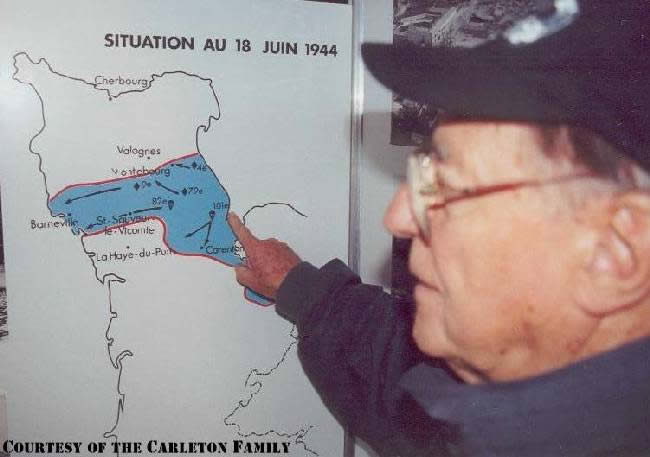
Robert 'Bob' Carleton shows where he landed during D-Day
Back in Normandy, Bob had another mission. Trying to find the exact spot where he landed during D-Day. Accompanied by his grandson Scott, he was full of faith he would find the place. 'At first I thought it was impossible, but one of the guys said France hasn't changed that much, so we will see.' So they got hold of a little car, and roamed through the bocages.
Tribute
Bob was a modest man who didn't speak much about
his experiences in World War Two.
He asked for a simple funeral ceremony. Nothing fancy.
But in conjunction with Betty, the love of his live, we decided to pay this
fitting tribute to a man who jumped into occupied Europe by choice, and fought
for our freedom.
All the way from the bocages of Normandy into Munich, Germany.
Robert 'Bob' Carleton, 502nd PIR, 101st AB. Screaming Eagle.
We will never forget you.
Airborne All the Way !!
Article and research by Donald van den Bogert
Sources / Credits:
Footnote: In my research on
Bob Carleton I have found out that other historians are also looking for
as much info as possible on the 502nd PIR. Like Ray Aebischer (F-Co 506th
PIR) who was looking for the whereabouts of the remains of Captain Fred
O Drennan. O Drennan, commander of E-Co 502nd PIR, KIA in The Netherlands
on September 22nd 1944.
As we understand a book will be released on E-Co 502nd PIR, 101st Airborne
Division, probably in 2004.